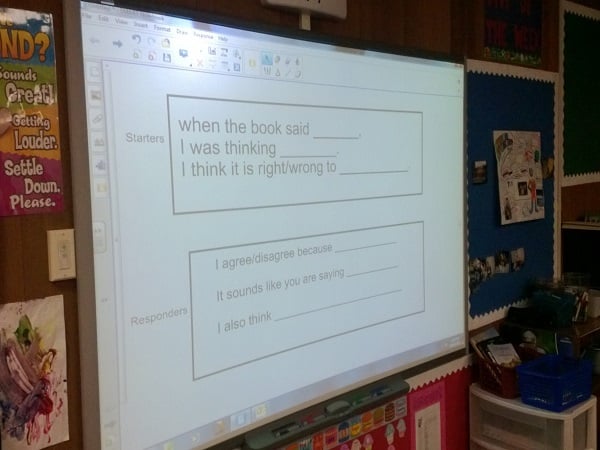Reading Test Prep: 6 Things You Are Already Doing

This is the time of year when teachers start to feel anxious about reading test prep for the upcoming high-stakes state assessments. No matter how effective your teaching has been all school year long, testing season raises doubts in teachers’ minds about whether or not they have done enough to prepare their students for state tests.


So first, let me assure you that you have been using some really great teaching strategies for reading test prep that will most surely transfer to a testing scenario.
1. You encourage students to practice reading and writing everyday.
This is the #1 way to prepare students for state assessments. The more reading and writing practice students have done, the more confident they will be going into a test-taking situation. While the amount of reading students complete is important, perhaps the type of reading students practice is just as, or more, important. Reading within instruction is more valuable than free reading. Students become more confident as readers when they are engaged in meaningful work in response to teacher selected texts. Work can include graphic organizers and note taking, but should also include book discussions with their peers and the larger class. While the bulk of test questions on state tests are multiple-choice, research shows that writing about text enhances reading comprehension. Writing text summaries and syntheses will provide the most powerful kind of preparation for these assessments (Shanahan, 2014).
2. You incorporate daily vocabulary instruction into your routine.
Many of the questions on high-stakes tests assess whether students can infer the meanings of unknown words from context. Students need consistent practice inferring the meanings of unknown words within their reading. This is very different than completing excessive vocabulary worksheets in the weeks leading up to the state test. Aim to explicitly teach five or more vocabulary words each week within your reading instruction, as well as five or more vocabulary words a week in the content areas. Have students attend to the morphemes and context to infer the meaning of the word before looking the word up in the dictionary. To cement new vocabulary into students’ lexicon, ensure that students have immediate opportunities to use new vocabulary in speaking and writing. Do not underestimate the amount of words students gain indirectly through volume of reading! (see #1)
3. You teach with complex texts.
Make sure the texts that you are assigning are sufficiently difficult, and provide students with scaffolding that allows them to perform well with these texts (Shanahan, Fisher, & Frey, 2012). Do not spend the bulk of your year teaching from short passages and excerpts of longer texts. Instead, practice whole text reading and introduce a wide selection of chapter books and longer nonfiction. Later, when they come to that much shorter assessment passage, it will seem easy!
4. You help students get in the practice of defending their thinking with textual evidence.
Not only should students be giving evidence to support their thinking (when discussing their books, when taking notes on their books, when writing about their books, when speaking about their books), they should also be able to articulate what evidences are the strongest. Simply giving evidence of thinking is not enough because on state tests they are often looking for the BEST answer. Make sure the question, “Which piece of evidence is the best and why?” becomes a part of classroom practice. (This is why I love teaching about the turning point in the C. I. A. Units of Study!)
5. You explicitly teach students about genre, and practice reading in a variety of genres across the school year.
One thing I know about state tests is, you will never be able to accurately predict what topics will be introduced in the reading passages. I have had students reading about raccoons one year, and kayaking the next! But, what I can predict, quite accurately, are the genres students will encounter each year. I can typically expect students to have to read the following genres within the test: narrative nonfiction (usually biography), informational nonfiction, realistic fiction, and historical fiction or nonfiction. Rarely do I see fantasy, mystery, or science fiction come up on state tests (though they should probably know these genres too!). Make sure students know that these genres are predictable—you know what to expect every time you read a biography, for example. Teach them what to pay attention to, and teach them what themes emerge when reading these genres. This will go a long way to ensuring students’ confidence come testing time! (One other tip about genre: Plan to teach a nonfiction unit prior to the state test.)
(I recommend C. I. A. Units 3.3, 4.4, 5.4, or 6.3.)
6. Instead of expecting students to know how to access 29+ strategies and skills, you focus instruction on text structure.
Students, who are aware of text structure as they read, organize and retain the information as they read (Rand, 2002). Knowledge of text structure is vital to improving reading comprehension (Meyer, Brandt & Bluth, 1980; Richgels, McGee, Lomax & Sheard, 1987 & Gersten, Fuchs, Williams & Baker, 2001). Text structure knowledge gives rise to strategic thinking by guiding the reader’s predictions and providing a scaffold for organizing, remembering and retelling information. From the first point in a reading passage when the reader is sorting out characters, setting and goals, to the end point of the passage when the reader is grappling with theme, his knowledge of text structure drives his thinking. Encourage students to divide the passage on the state test into four relatively equal quadrants, and read according to the C. I. A.—Collect, Interpret, Apply—method (Collinge, 2011). This will help students pay attention to what is important in each section of the text making it easier to go back into the text later to find answers and evidences.
How much time should be spent preparing students for the state test?
Keep test prep to a minimum and focus on teaching strategic reading all year long using the above strategies. Then teach the test- taking genre and walk students through practice assessments in just two-weeks. If you spend more than two weeks on the test-taking genre, students will begin to see test taking as the end goal. Is that the goal you are hoping to achieve? I hope the answer is no. I hope the end goal is a life-long appreciation for reading!

Are you looking for a reading program to increase motivation and achievement?
We are confident the Read Side by Side Reading Program will be the right fit for your next curriculum adoption! To learn more about the program and request a sample kit, connect with one of our advisors!

Written by Sarah Collinge
Founder & President
Read Side by Side Publications, LLC.
References
Meyer, B. J. F., Brandt, D. M., & Bluth, G. J. (1980). Use of top-level structure in text: Key for reading comprehension of ninth-grade students. Reading Research Quarterly, 16(1), 72-103.
RAND Reading Study Group. (2002). Reading for understanding: Toward an R & D program in reading comprehension. Santa Monica, CA: RAND.
Shanahan, T. (2014). How and how not to prepare students for the new tests. The Reading Teacher, 68(3), 184–188.
Shanahan, T., Fisher, D., & Frey, N. (2012). The challenge of challenging text. Educational Leadership, 69(6), 58–63.



.png)